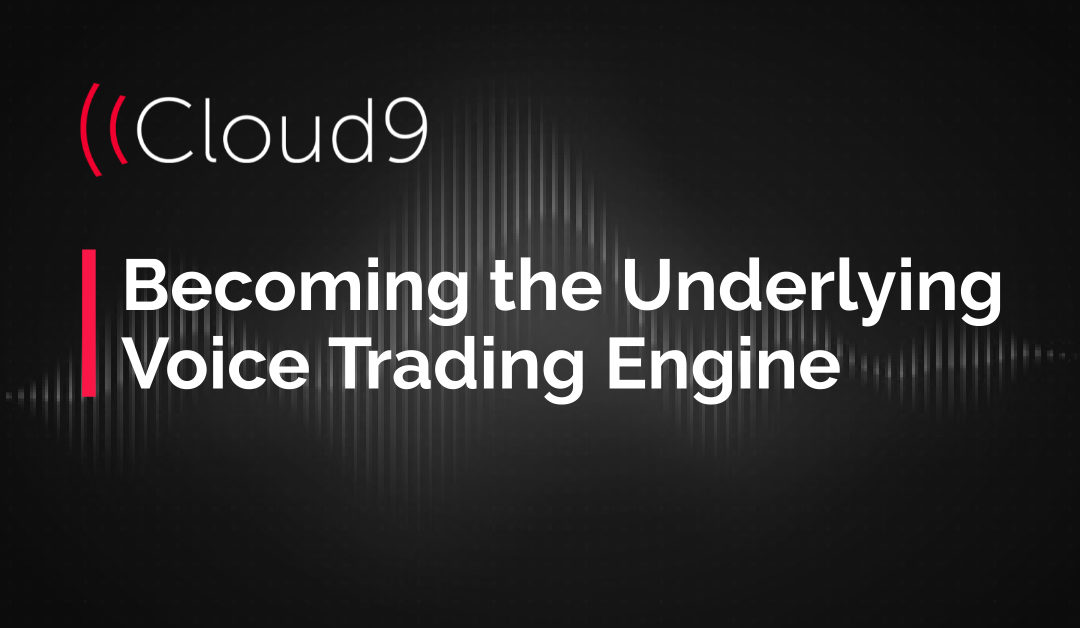
Becoming the Underlying Voice Trading Engine
Capital markets have undergone a seismic shift in recent years, particularly with the accelerated adoption of technology and cloud-based solutions over the last 15 months. One thing that has not changed, however, is the importance voice trading continues to play in the institutional landscape. And with the increasing levels of sophistication that are enabling individuals on and off the trading floor to communicate with each other – particularly through more advanced APIs – there is now a greater appetite than ever before for cloud-based trading solutions.
The days of solely relying on traditional trading turrets and private wires are dwindling away. Filling that gap are cloud-based, API-driven trading platforms that are driving innovation, enabling firms to streamline workflows, and empowering access to a virtual trading floor that will very soon become the norm across the industry.
In the last year alone, there has been more adoption of cloud than in the ten years prior combined. The pandemic has been a key driver, although this transition was certainly underway prior to last March. When remote working began last March, every firm had to quickly transition to 100% remote – something that cloud-based trading solutions and APIs already enable.
Firms are not only more comfortable with data residing in the cloud but they are now more frequently coming to vendors for help. In fact, leadership at major banks and financial institutions is becoming more outspoken about the need for cloud.
Some customers are generating more than 300,000 voice trading recordings each month. Thanks to advanced APIs and natural language processing (NLP) technology, firms are able to capture the audio of these conversations with 99% accuracy. This not only simplifies the regulatory and compliance process but also delivers more actionable insights that elevate performance.
Two things are becoming very clear. The capabilities for firms to efficiently and securely conduct voice trading in the cloud are there. Firms are becoming far more comfortable using the cloud to access a virtual trading floor and with storing data there.
However, with the growing appetite – and the need – for cloud-based voice trading capabilities, therein lies a growing responsibility for the technology vendors to continue pushing the innovation curve and fuel the voice trading engine.
The Vendor Responsibility
Much like other areas of the institutional ecosystem, the approach to voice trading has shifted for many participants. Today, working from anywhere is a basic necessity and having access to data from anywhere is critical. The key driver in developing technology that can support these changes has and will continue to be listening to customers and addressing their concerns.
API-based platforms are quickly becoming the foundation for the institutional voice trading ecosystem, allowing third parties to access unique voice data and integrate with best-of-breed analytics and surveillance providers. APIs can also ingest rich sources of data that can help analyze and improve the productivity of traders.
About two years ago, remote virtual desktop infrastructure (VDI) began to gain traction and is now enabling more of a hybrid approach for folks who prefer to share time between the trading floors and a remote work environment. Moving forward, support around VDI and ‘work from anywhere’ will become central to everything in institutional trading.
With a greater selection of collaboration tools available and more ways to talk to customers, technology and structural complexities are inevitable. It is up to the vendors to address these hurdles by integrating data with back-office systems and data warehouses.
Becoming the Industry Engine
Voice trading is not a one-size-fits-all. Customers want optionality and the ability to customize workflows. Some have already immersed themselves in the cloud while others still seek a traditional phone turret experience.
With institutional IT teams focusing more on value-add than just on the overall infrastructure, vendors have to provide sufficient management so that IT teams can more easily and seamlessly implement these solutions into their own systems.
The most challenging part is understanding each customer. There are a variety of trader types and with that comes a variety of different workflows. Vendors that are providing voice trading capabilities need to define each of these workflows and have the APIs to support them.
What is most important is that a cloud-based virtual trading setup looks and feels the same for the users. While firms want options around how and where they can operate, they don’t want their teams needing to adapt to different systems depending on where they are on a particular day.
It is no longer about just providing voice capabilities. The focus now needs to be on providing all the voice trading capabilities customers need in a single, intuitive and interoperable platform that’s secure and accessible from anywhere.
Becoming the voice trading engine for the institutional capital markets will be no small task for any technology provider. But enabling anytime, anywhere access, and delivering the ability to digitize data from any conversation simplifies workflows and provides the actionable insights that firms need in our ever-evolving environment.
To learn more about voice trading capabilities and how to navigate the challenges you may be facing in our current environment, please attend our next virtual roundtable that will be co-hosted with EY on Thursday, July 22 at 10am ET. The event will focus on the importance of voice trading data. More information to come but you can secure your spot by emailing cloud9@paragonpr.com.
For more information on Cloud9’s voice trading and cloud solutions, please contact us at sales@c9tec.com.
